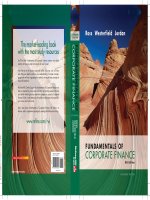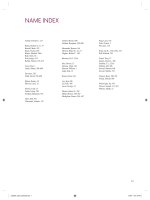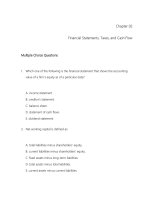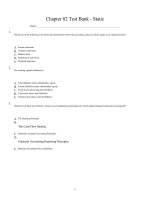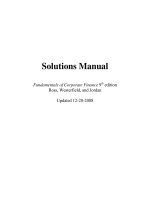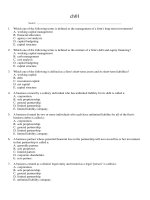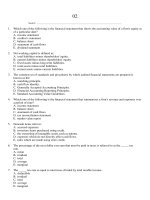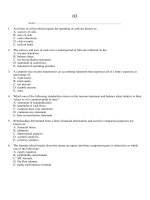solutions manual fundamentals of corporate finance 11th edition ross westerfield jordan
Bạn đang xem bản rút gọn của tài liệu. Xem và tải ngay bản đầy đủ của tài liệu tại đây (520.45 KB, 16 trang )
Solutions manual Fundamentals of Corporate Finance 11th Edition Ross Westerfield Jordan
Solutions manual Fundamentals of Corporate Finance 11th Edition Ross
Westerfield Jordan
CHAPTER 1
INTRODUCTION TO CORPORATE
FINANCE
Answers to Concepts Review and Critical Thinking Questions
1.
Capital budgeting (deciding whether to expand a manufacturing plant), capital structure (deciding
whether to issue new equity and use the proceeds to retire outstanding debt), and working capital
management (modifying the firm’s credit collection policy with its customers).
2.
Disadvantages: unlimited liability, limited life, difficulty in transferring ownership, difficulty in
raising capital funds. Some advantages: simpler, less regulation, the owners are also the managers,
sometimes personal tax rates are better than corporate tax rates.
3.
The primary disadvantage of the corporate form is the double taxation to shareholders of distributed
earnings and dividends. Some advantages include: limited liability, ease of transferability, ability to
raise capital, and unlimited life.
4.
In response to Sarbanes-Oxley, small firms have elected to go dark because of the costs of compliance.
The costs to comply with Sarbox can be several million dollars, which can be a large percentage of a
small firm’s profits. A major cost of going dark is less access to capital. Since the firm is no longer
publicly traded, it can no longer raise money in the public market. Although the company will still
have access to bank loans and the private equity market, the costs associated with raising funds in
these markets are usually higher than the costs of raising funds in the public market.
5.
The treasurer’s office and the controller’s office are the two primary organizational groups that report
directly to the chief financial officer. The controller’s office handles cost and financial accounting, tax
management, and management information systems, while the treasurer’s office is responsible for cash
and credit management, capital budgeting, and financial planning. Therefore, the study of corporate
finance is concentrated within the treasury group’s functions.
6.
To maximize the current market value (share price) of the equity of the firm (whether it’s publicly
traded or not).
7.
In the corporate form of ownership, the shareholders are the owners of the firm. The shareholders elect
the directors of the corporation, who in turn appoint the firm’s management. This separation of
ownership from control in the corporate form of organization is what causes agency problems to exist.
Management may act in its own or someone else’s best interests, rather than those of the shareholders.
If such events occur, they may contradict the goal of maximizing the share price of the equity of the
firm.
Fundamentals of Corporate Finance 11th Edition Solutions manual Ross Westerfield Jordan
8.
A primary market transaction.
CHAPTER 1 - 3
9.
In auction markets like the NYSE, brokers and agents meet at a physical location (the exchange) to
match buyers and sellers of assets. Dealer markets like NASDAQ consist of dealers operating at
dispersed locales who buy and sell assets themselves, communicating with other dealers either
electronically or literally over-the-counter.
10. Such organizations frequently pursue social or political missions, so many different goals are
conceivable. One goal that is often cited is revenue minimization; that is, provide whatever goods and
services are offered at the lowest possible cost to society. A better approach might be to observe that
even a not-for-profit business has equity. Thus, one answer is that the appropriate goal is to maximize
the value of the equity.
11. Presumably, the current stock value reflects the risk, timing, and magnitude of all future cash flows,
both short-term and long-term. If this is correct, then the statement is false.
12. An argument can be made either way. At the one extreme, we could argue that in a market economy,
all of these things are priced. There is thus an optimal level of, for example, ethical and/or illegal
behavior, and the framework of stock valuation explicitly includes these. At the other extreme, we
could argue that these are noneconomic phenomena and are best handled through the political process.
A classic (and highly relevant) thought question that illustrates this debate goes something like this:
“A firm has estimated that the cost of improving the safety of one of its products is $30 million.
However, the firm believes that improving the safety of the product will only save $20 million in
product liability claims. What should the firm do?”
13. The goal will be the same, but the best course of action toward that goal may be different because of
differing social, political, and economic institutions.
14. The goal of management should be to maximize the share price for the current shareholders. If
management believes that it can improve the profitability of the firm so that the share price will exceed
$35, then they should fight the offer from the outside company. If management believes that this bidder
or other unidentified bidders will actually pay more than $35 per share to acquire the company, then
they should still fight the offer. However, if the current management cannot increase the value of the
firm beyond the bid price, and no other higher bids come in, then management is not acting in the
interests of the shareholders by fighting the offer. Since current managers often lose their jobs when
the corporation is acquired, poorly monitored managers have an incentive to fight corporate takeovers
in situations such as this.
15. We would expect agency problems to be less severe in countries with a relatively small percentage of
individual ownership. Fewer individual owners should reduce the number of diverse opinions
concerning corporate goals. The high percentage of institutional ownership might lead to a higher
degree of agreement between owners and managers on decisions concerning risky projects. In addition,
institutions may be better able to implement effective monitoring mechanisms on managers than can
individual owners, based on the institutions’ deeper resources and experiences with their own
management. The increase in institutional ownership of stock in the United States and the growing
activism of these large shareholder groups may lead to a reduction in agency problems for U.S.
corporations and a more efficient market for corporate control.
Fundamentals of Corporate Finance 11th Edition Solutions manual Ross Westerfield Jordan
16. How much is too much? Who is worth more, Lawrence Ellison or Tiger Woods? The simplest answer
is that there is a market for executives just as there is for all types of labor. Executive compensation is
the price that clears the market. The same is true for athletes and performers. Having said that, one
aspect of executive compensation deserves comment. A primary reason executive compensation has
grown so dramatically is that companies have increasingly moved to stock-based compensation. Such
movement is obviously consistent with the attempt to better align stockholder and management
interests. In recent years, stock prices have soared, so management has cleaned up. It is sometimes
argued that much of this reward is simply due to rising stock prices in general, not managerial
performance. Perhaps in the future, executive compensation will be designed to reward only
differential performance, that is, stock price increases in excess of general market increases.
Solutions manual Fundamentals of Corporate Finance 11th Edition Ross Westerfield Jordan
CHAPTER 2
FINANCIAL STATEMENTS, TAXES, AND
CASH FLOW
Answers to Concepts Review and Critical Thinking Questions
1.
Liquidity measures how quickly and easily an asset can be converted to cash without significant loss
in value. It’s desirable for firms to have high liquidity so that they have a large factor of safety in
meeting short-term creditor demands. However, since liquidity also has an opportunity cost associated
with it—namely that higher returns can generally be found by investing the cash into productive
assets—low liquidity levels are also desirable to the firm. It’s up to the firm’s financial management
staff to find a reasonable compromise between these opposing needs.
2.
The recognition and matching principles in financial accounting call for revenues, and the costs
associated with producing those revenues, to be “booked” when the revenue process is essentially
complete, not necessarily when the cash is collected or bills are paid. Note that this way is not
necessarily correct; it’s the way accountants have chosen to do it.
3.
Historical costs can be objectively and precisely measured whereas market values can be difficult to
estimate, and different analysts would come up with different numbers. Thus, there is a trade-off
between relevance (market values) and objectivity (book values).
4.
Depreciation is a noncash deduction that reflects adjustments made in asset book values in accordance
with the matching principle in financial accounting. Interest expense is a cash outlay, but it’s a
financing cost, not an operating cost.
5.
Market values can never be negative. Imagine a share of stock selling for –$20. This would mean that
if you placed an order for 100 shares, you would get the stock along with a check for $2,000. How
many shares do you want to buy? More generally, because of corporate and individual bankruptcy
laws, net worth for a person or a corporation cannot be negative, implying that liabilities cannot exceed
assets in market value.
6.
For a successful company that is rapidly expanding, for example, capital outlays will be large, possibly
leading to negative cash flow from assets. In general, what matters is whether the money is spent
wisely, not whether cash flow from assets is positive or negative.
7.
It’s probably not a good sign for an established company, but it would be fairly ordinary for a startup, so it depends.
8.
For example, if a company were to become more efficient in inventory management, the amount of
inventory needed would decline. The same might be true if it becomes better at collecting its
receivables. In general, anything that leads to a decline in ending NWC relative to beginning would
have this effect. Negative net capital spending would mean more long-lived assets were liquidated
than purchased.
Fundamentals of Corporate Finance 11th Edition Solutions manual Ross Westerfield Jordan
9.
If a company raises more money from selling stock than it pays in dividends in a particular period, its
cash flow to stockholders will be negative. If a company borrows more than it pays in interest, its cash
flow to creditors will be negative.
10. The adjustments discussed were purely accounting changes; they had no cash flow or market value
consequences unless the new accounting information caused stockholders to revalue the derivatives.
11. Enterprise value is the theoretical takeover price. In the event of a takeover, an acquirer would have
to take on the company's debt but would pocket its cash. Enterprise value differs significantly from
simple market capitalization in several ways, and it may be a more accurate representation of a firm's
value. In a takeover, the value of a firm's debt would need to be paid by the buyer. Thus, enterprise
value provides a much more accurate takeover valuation because it includes debt in its value
calculation.
12. In general, it appears that investors prefer companies that have a steady earnings stream. If true, this
encourages companies to manage earnings. Under GAAP, there are numerous choices for the way a
company reports its financial statements. Although not the reason for the choices under GAAP, one
outcome is the ability of a company to manage earnings, which is not an ethical decision. Even though
earnings and cash flow are often related, earnings management should have little effect on cash flow
(except for tax implications). If the market is “fooled” and prefers steady earnings, shareholder wealth
can be increased, at least temporarily. However, given the questionable ethics of this practice, the
company (and shareholders) will lose value if the practice is discovered.
Solutions to Questions and Problems
NOTE: All end of chapter problems were solved using a spreadsheet. Many problems require multiple
steps. Due to space and readability constraints, when these intermediate steps are included in this solutions
manual, rounding may appear to have occurred. However, the final answer for each problem is found
without rounding during any step in the problem.
Basic
1.
To find owners’ equity, we must construct a balance sheet as follows:
CA
NFA
TA
Balance Sheet
CL
LTD
OE
$30,200
TL & OE
$ 5,300
24,900
$ 4,600
10,300
??
$30,200
We know that total liabilities and owners’ equity (TL & OE) must equal total assets of $30,200.
We also know that TL & OE is equal to current liabilities plus long-term debt plus owners’ equity,
so owners’ equity is:
Owner’s equity = $30,200 – 10,300 – 4,600 = $15,300
NWC = CA – CL = $5,300 – 4,600 = $700
CHAPTER 2 - 7
2.
The income statement for the company is:
Income Statement
Sales
$817,000
Costs
343,000
Depreciation
51,000
EBIT
$423,000
Interest
38,000
EBT
$385,000
Taxes (35%)
134,750
Net income
$250,250
3.
One equation for net income is:
Net income = Dividends + Addition to retained earnings
Rearranging, we get:
Addition to retained earnings = Net income – Dividends = $250,250 – 95,000 = $155,250
4.
EPS = Net income / Shares = $250,250 / 90,000 = $2.78 per share
DPS = Dividends / Shares
= $95,000 / 90,000
= $1.06 per share
5.
Taxes = .15($50,000) + .25($25,000) + .34($25,000) + .39($267,000 – 100,000) = $87,380
6.
The average tax rate is the total tax paid divided by taxable income, so:
Average tax rate = $87,380 / $267,000 = .3273, or 32.73%
The marginal tax rate is the tax rate on the next $1 of earnings, so the marginal tax rate = 39%.
7.
To calculate OCF, we first need the income statement:
Income Statement
Sales
$43,800
Costs
22,700
Depreciation
2,100
EBIT
$19,000
Interest
1,600
Taxable income
$17,400
Taxes (35%)
6,090
Net income
$11,310
OCF = EBIT + Depreciation – Taxes = $19,000 + 2,100 – 6,090 = $15,010
8.
Net capital spending = NFAend – NFAbeg + Depreciation
Net capital spending = $3,500,000 – 2,700,000 + 328,000
Net capital spending = $1,128,000
Fundamentals of Corporate Finance 11th Edition Solutions manual Ross Westerfield Jordan
9.
Change in NWC = NWCend – NWCbeg
Change in NWC = (CAend – CLend) – (CAbeg – CLbeg)
Change in NWC = ($5,180 – 2,830) – ($4,630 – 2,190)
Change in NWC = $2,350 – 2,440 = –$90
10.
Cash flow to creditors = Interest paid – Net new borrowing
Cash flow to creditors = Interest paid – (LTDend – LTDbeg)
Cash flow to creditors = $235,000 – ($2,280,000 – 1,950,000)
Cash flow to creditors = –$95,000
11.
Cash flow to stockholders = Dividends paid – Net new equity
Cash flow to stockholders = Dividends paid – [(Commonend + APISend) – (Commonbeg + APISbeg)]
Cash flow to stockholders = $565,000 – [($825,000 + 4,400,000) – ($670,000 + 4,100,000)]
Cash flow to stockholders = $110,000
Note, APIS is the additional paid-in surplus.
12.
Cash flow from assets = Cash flow to creditors + Cash flow to stockholders
= –$95,000 + 110,000 = $15,000
Cash flow from assets = $15,000 = OCF – Change in NWC – Net capital spending
= $15,000 = OCF – (–$45,000) – 1,250,000
Operating cash flow
Operating cash flow
= $15,000 – 45,000 + 1,250,000
= $1,220,000
Intermediate
13.
To find the book value of current assets, we use: NWC = CA – CL. Rearranging to solve for current
assets, we get:
CA = NWC + CL = $220,000 + 850,000 = $1,070,000
The market value of current assets and fixed assets is given, so:
Book value CA
= $1,070,000
Book value NFA = $3,300,000
Book value assets = $4,370,000
NWC
Market value NFA
Total
= $1,050,000
= $4,800,000
= $5,850,000
CHAPTER 2 - 9
14.
To find the OCF, we first calculate net income.
Income Statement
Sales
$267,000
Costs
148,000
Other expenses
8,200
Depreciation
17,600
EBIT
$ 93,200
Interest
12,400
Taxable income
$ 80,800
Taxes
32,620
Net income
$ 48,180
Dividends
Additions to RE
$15,500
$32,680
a. OCF = EBIT + Depreciation – Taxes = $93,200 + 17,600 – 32,620 = $78,180
b. CFC = Interest – Net new LTD = $12,400 – (–4,900) = $17,300
Note that the net new long-term debt is negative because the company repaid part of its longterm debt.
c. CFS = Dividends – Net new equity = $15,500 – 6,400 = $9,100
d. We know that CFA = CFC + CFS, so:
CFA = $17,300 + 9,100 = $26,400
CFA is also equal to OCF – Net capital spending – Change in NWC. We already know OCF.
Net capital spending is equal to:
Net capital spending = Increase in NFA + Depreciation = $25,000 + 17,600 = $42,600
Now we can use:
CFA = OCF – Net capital spending – Change in NWC
$26,400 = $78,180 – 42,600 – Change in NWC
Change in NWC = $9,180
This means that the company increased its NWC by $9,180.
Fundamentals of Corporate Finance 11th Edition Solutions manual Ross Westerfield Jordan
15.
The solution to this question works the income statement backwards. Starting at the bottom:
Net income = Dividends + Addition to retained earnings = $1,950 + 5,600 = $7,550
Now, looking at the income statement:
EBT – EBT × Tax rate = Net income
Recognize that EBT × Tax rate is simply the calculation for taxes. Solving this for EBT yields:
EBT = NI / (1– Tax rate) = $7,550 / (1 – .35) = $11,615
Now you can calculate:
EBIT = EBT + Interest = $11,615 + 4,300 = $15,915
The last step is to use:
EBIT = Sales – Costs – Depreciation
$15,915 = $61,000 – 29,600 – Depreciation
Depreciation = $15,485
16.
The balance sheet for the company looks like this:
Cash
Accounts receivable
Inventory
Current assets
Tangible net fixed assets
Intangible net fixed assets
Total assets
Balance Sheet
$ 134,000
Accounts payable
105,000
Notes payable
293,000
Current liabilities
$ 532,000
Long-term debt
Total liabilities
1,730,000
670,000
Common stock
Accumulated ret. earnings
$2,932,000
Total liab. & owners’ equity
$ 210,000
160,000
$ 370,000
845,000
$1,215,000
??
1,453,000
$2,932,000
Total liabilities and owners’ equity is:
TL & OE = CL + LTD + Common stock + Retained earnings
Solving this equation for common stock gives us:
Common stock = $2,932,000 – 1,215,000 – 1,453,000 = $264,000
17.
The market value of shareholders’ equity cannot be negative. A negative market value in this case
would imply that the company would pay you to own the stock. The market value of shareholders’
equity can be stated as: Shareholders’ equity = Max [(TA – TL), 0]. So, if TA are $8,7000, equity
is equal to $1,900, and if TA are $5,900, equity is equal to $0. We should note here that the book
value of shareholders’ equity can be negative.
CHAPTER 2 - 11
18.
a. Taxes Growth = .15($50,000) + .25($25,000) + .34($14,500) = $18,680
Taxes Income = .15($50,000) + .25($25,000) + .34($25,000) + .39($235,000)
+ .34($8,950,000 – 335,000) = $3,043,000
b. Each firm has a marginal tax rate of 34% on the next $10,000 of taxable income, despite their
different average tax rates, so both firms will pay an additional $3,400 in taxes.
19.
a.
Income Statement
Sales
$675,000
COGS
435,000
A&S expenses
85,000
Depreciation
125,000
EBIT
$30,000
Interest
70,000
Taxable income
–$40,000
Taxes (35%)
0
Net income
–$40,000
b. OCF = EBIT + Depreciation – Taxes = $30,000 + 125,000 – 0 = $155,000
c. Net income was negative because of the tax deductibility of depreciation and interest expense.
However, the actual cash flow from operations was positive because depreciation is a non-cash
expense and interest is a financing expense, not an operating expense.
20.
A firm can still pay out dividends if net income is negative; it just has to be sure there is sufficient
cash flow to make the dividend payments.
Change in NWC = Net capital spending = Net new equity = 0. (Given)
Cash flow from assets = OCF – Change in NWC – Net capital spending
Cash flow from assets = $155,000 – 0 – 0 = $155,000
Cash flow to stockholders = Dividends – Net new equity = $102,000 – 0 = $102,000
Cash flow to creditors = Cash flow from assets – Cash flow to stockholders
Cash flow to creditors = $155,000 – 102,000 = $53,000
Cash flow to creditors = Interest – Net new LTD
Net new LTD = Interest – Cash flow to creditors = $70,000 – 53,000 = $17,000
21.
a.
Income Statement
Sales
Cost of goods sold
Depreciation
EBIT
Interest
Taxable income
Taxes (35%)
Net income
$30,096
21,476
5,341
$ 3,279
2,409
$ 870
305
$ 566
b. OCF = EBIT + Depreciation – Taxes
= $3,279 + 5,341 – 305 = $8,316
Fundamentals of Corporate Finance 11th Edition Solutions manual Ross Westerfield Jordan
c. Change in NWC = NWCend – NWCbeg
= (CAend – CLend) – (CAbeg – CLbeg)
= ($7,829 – 4,159) – ($6,336 – 3,564)
= $3,670 – 2,772 = $898
Net capital spending = NFAend – NFAbeg + Depreciation
= $22,176 – 18,018 + 5,341 = $9,499
CFA
= OCF – Change in NWC – Net capital spending
= $8,316 – 898 – 9,499 = –$2,082
The cash flow from assets can be positive or negative, since it represents whether the firm
raised funds or distributed funds on a net basis. In this problem, even though net income and
OCF are positive, the firm invested heavily in both fixed assets and net working capital; it had
to raise a net $2,082 in funds from its stockholders and creditors to make these investments.
d. Cash flow to creditors
Cash flow to stockholders
= Interest – Net new LTD = $2,409 – 0 = $2,409
= Cash flow from assets – Cash flow to creditors
= –$2,082 – 2,409 = –$4,491
We can also calculate the cash flow to stockholders as:
Cash flow to stockholders
= Dividends – Net new equity
Solving for net new equity, we get:
Net new equity
= $1,716 – (–4,491) = $6,207
The firm had positive earnings in an accounting sense (NI > 0) and had positive cash flow from
operations. The firm invested $898 in new net working capital and $9,499 in new fixed assets.
The firm had to raise $2,082 from its stakeholders to support this new investment. It
accomplished this by raising $6,207 in the form of new equity. After paying out $1,716 of this
in the form of dividends to shareholders and $2,409 in the form of interest to creditors, $2,082
was left to meet the firm’s cash flow needs for investment.
22.
a. Total assets 2014
= $1,005 + 4,144 = $5,149
Total liabilities 2014 = $402 + 2,190= $2,592
Owners’ equity 2014 = $5,149 – 2,592 = $2,557
Total assets 2015
= $1,089 + 4,990 = $6,079
Total liabilities 2015 = $451 + 2,329 = $2,780
Owners’ equity 2015 = $6,079 – 2,780 = $3,299
b. NWC 2014
= CA14 – CL14 = $1,005 – 402 = $603
NWC 2015
= CA15 – CL15 = $1,089 – 451 = $638
Change in NWC = NWC15 – NWC14 = $638 – 603 = $35
CHAPTER 2 - 13
c. We can calculate net capital spending as:
Net capital spending = Net fixed assets 2015 – Net fixed assets 2014 + Depreciation
Net capital spending = $4,990 – 4,144 + 1,136 = $1,982
So, the company had a net capital spending cash flow of $1,982. We also know that net capital
spending is:
Net capital spending = Fixed assets bought – Fixed assets sold
$1,982
= $2,080 – Fixed assets sold
Fixed assets sold
= $2,080 – 1,982 = $98
To calculate the cash flow from assets, we must first calculate the operating cash flow. The
income statement is:
Income Statement
Sales
Costs
Depreciation expense
EBIT
Interest expense
EBT
Taxes (35%)
Net income
$12,751
5,946
1,136
$ 5,669
323
$ 5,346
1,871
$ 3,475
So, the operating cash flow is:
OCF = EBIT + Depreciation – Taxes = $5,669 + 1,136 – 1,871 = $4,934
And the cash flow from assets is:
Cash flow from assets = OCF – Change in NWC – Net capital spending.
= $4,934 – 35 – 1,982 = $2,917
d. Net new borrowing
Cash flow to creditors
Net new borrowing
Debt retired
= LTD15 – LTD14 = $2,329 – 2,190 = $139
= Interest – Net new LTD = $323 – 139 = $184
= $139 = Debt issued – Debt retired
= $420 – 139 = $281
Challenge
23.
Net capital spending = NFAend – NFAbeg + Depreciation
= (NFAend – NFAbeg) + (Depreciation + ADbeg) – ADbeg
= (NFAend – NFAbeg)+ ADend – ADbeg
= (NFAend + ADend) – (NFAbeg + ADbeg)
= FAend – FAbeg
Fundamentals of Corporate Finance 11th Edition Solutions manual Ross Westerfield Jordan
24.
a. The tax bubble causes average tax rates to catch up to marginal tax rates, thus eliminating the
tax advantage of low marginal rates for high income corporations.
b. Taxes = .15($50,000) + .25($25,000) + .34($25,000) + .39($235,000) = $113,900
Average tax rate = $113,900 / $335,000 = .34, or 34%
The marginal tax rate on the next dollar of income is 34 percent.
For corporate taxable income levels of $335,000 to $10 million, average tax rates are equal to
marginal tax rates.
Taxes = .34($10,000,000) + .35($5,000,000) + .38($3,333,333) = $6,416,667
Average tax rate = $6,416,667 / $18,333,333 = .35, or 35%
The marginal tax rate on the next dollar of income is 35 percent. For corporate taxable income
levels over $18,333,334, average tax rates are again equal to marginal tax rates.
c. Taxes
$68,000
X($100,000)
X
X
= .34($200,000) = $68,000
= .15($50,000) + .25($25,000) + .34($25,000) + X($100,000);
= $68,000 – 22,250
= $45,750 / $100,000
= 45.75%
25.
Cash
Accounts receivable
Inventory
Current assets
Balance sheet as of Dec. 31, 2014
$ 6,674
Accounts payable
8,837
Notes payable
15,711
Current liabilities
$ 6,110
$22,352
$58,737
$87,199
$31,222
Net fixed assets
$55,977
Long-term debt
Owners' equity
Total assets
$87,199
Total liab. & equity
Cash
Accounts receivable
Inventory
Current assets
$ 4,822
1,288
Balance sheet as of Dec. 31, 2015
$ 7,113
Accounts payable
10,371
Notes payable
16,817
$ 5,1008
1,262
Current liabilities
$ 6,370
$27,099
$60,532
$94,001
$34,301
Net fixed assets
$59,700
Long-term debt
Owners' equity
Total assets
$94,001
Total liab. & equity
CHAPTER 2 - 15
26.
2014 Income Statement
Sales
$12,730.00
COGS
4,377.00
Other expenses
1,041.00
Depreciation
1,827.00
EBIT
$5,485.00
Interest
854.00
EBT
$4,631.00
Taxes (34%)
1,574.54
Net income
$3,056.46
2015 Income Statement
Sales
$14,229.00
COGS
5,178.00
Other expenses
906.00
Depreciation
1,910.00
EBIT
$6,235.00
Interest
1,019.00
EBT
$5,216.00
Taxes (34%)
1,773.44
Net income
$3,442.56
Dividends
Additions to RE
Dividends
Additions to RE
$1,522.00
1,534.46
$1,780.00
1,662.56
OCF = EBIT + Depreciation – Taxes = $6,235 + 1,910 – 1,773.44 = $6,371.56
Change in NWC = NWCend – NWCbeg = (CA – CL) end – (CA – CL) beg
= ($34,301 – 6,370) – ($31,222 – 6,110)
= $2,819
Net capital spending = NFAend – NFAbeg + Depreciation
= $59,700 – 55,977 + 1,910 = $5,633
Cash flow from assets = OCF – Change in NWC – Net capital spending
= $6,371.56 – 2,819 – 5,633 = –$2,080.44
Cash flow to creditors = Interest – Net new LTD
Net new LTD = LTDend – LTDbeg
Cash flow to creditors = $1,019 – ($27,099 – 22,352) = –$3,728
Net new equity = Common stockend – Common stockbeg
Common stock + Retained earnings = Total owners’ equity
Net new equity = (OE – RE) end – (OE – RE) beg
= OEend – OEbeg + REbeg – REend
REend = REbeg + Additions to RE15
Net new equity
= OEend – OEbeg + REbeg – (REbeg + Additions to RE15)
= OEend – OEbeg – Additions to RE
Net new equity
= $60,532 – 58,737 – 1,662.56 = $132.44
CFS
CFS
= Dividends – Net new equity
= $1,780 – 132.44 = $1,647.56
As a check, cash flow from assets is –$2,080.44.
CFA
CFA
= Cash flow from creditors + Cash flow to stockholders
= –$3,278 + 1,647.56 = –$2,080.44
Solutions manual Fundamentals of Corporate Finance 11th Edition Ross Westerfield Jordan
Complete download Solutions Manual for Fundamentals of Corporate Finance 11th
Edition Ross Westerfield Jordan.
/>Complete download Test Bank for Fundamentals of Corporate Finance 11th
Edition Ross Westerfield Jordan:
/>
Related download link:
fundamentals of corporate finance 11th edition solutions pdf
fundamentals of corporate finance 11th edition test bank
fundamentals of corporate finance 11th edition solutions manual free download
sample
fundamentals of corporate finance 10th edition solutions manual pdf
corporate finance ross 10th edition solutions manual
fundamentals of corporate finance ross
fundamentals of corporate finance 9th edition solutions manual pdf
fundamentals of corporate finance 10th edition solutions pdf
corporate finance ross 10th edition solutions manual pdf


